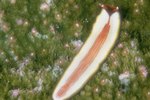
A close-up examination of any insect reveals its eyes are not like those associated with mammals. Instead, most adult insects have compound eyes which make them excellent at seeing movement. Even though compound eyes are common, each species’ eyes have adapted differently to make them more successful at surviving in the natural world. However, other types of eyes also exist among insects, including the ocelli, the stemmata and genitalic photoreceptors.
Compound Eyes

Compound eyes get their name because they are actually made up of multiple ommatidia and each one is capable of picking up visual information. In fact, each one is essentially a separate eye containing a lens, a cone, pigment cells and visual cells sensitive to light. An insect's compound eyes contain thousands of these ommatidia and each one collects visual information that is composited in the insect's brain. The number of ommatidia in the compound eyes affects how detailed the image is. In some insects, the ommatidia contain pigments that allow them to recognize colors, including yellow-green, blue and ultraviolet light.
Ocelli: The Simple Eye

Ocelli differ from compound eyes in that they contain only a single structure instead of multiple ones. As a result, they are sometimes called "simple" eyes. All adult insects who have compound eyes also have ocelli, usually located on their back or face. Nymphs or naiads of some species, such as the dragonfly or mayfly, also have ocelli. Unlike their larger, more prominent compound eyes, insects' ocelli appear as small swellings. Insects can have two to three simple eyes which are not used for discriminating among visual images, but instead are useful for detecting changes in light.
Stemmata: Lateral Ocelli

The stemmata are found specifically in the larvae forms of insects that go through a complete metamorphosis (egg, larva, pupa and adult stages), such as beetles, wasps, butterflies, flies and fleas. During the larval stage, these insects do not yet have their compound eyes and instead rely on the stemmata, which are essentially single ommatidia. The stemmata, sometimes referred to as lateral ocelli because these visual organs are located on the sides of the larva's head, can also recognize light changes, color, distance and form.
Photoreceptors in Unusual Locations

In addition to their compound and ocelli eyes, butterflies and moths have an additional pair of organs capable of detecting light, particularly ultraviolet light. This pair of photoreceptors is located on their genitals. According to a 1997 study published in the "Journal of Comparative Physiology," these photoreceptors appear to assist butterflies in the mating process. In the study, one pair of the photorecptors was damaged in male and female butterflies then they were allowed to mate. Only one-fourth of these males were able to successfully mate with the female butterfly (compared to two-thirds of non-damaged males). The study found that 40 percent of the damaged males could not locate the female's genitals in order to mate with her. Damage to the female's photoreceptors did not produce any noticeable differences in this particular study.
References
Photo Credits
-
Ablestock.com/AbleStock.com/Getty Images
Writer Bio
Amy Jorgensen has ghostwritten more than 100 articles and books on raising and training animals. She is also an amateur dog trainer. She has also written more than 200 blog posts, articles, and ebooks on wedding and party planning on behalf of professionals in the field.



